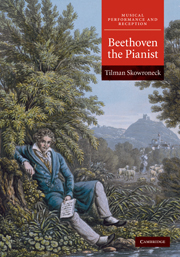Book contents
- Frontmatter
- Contents
- Acknowledgments
- Abbreviations and conventions
- Introduction
- PART I BEETHOVEN, HIS PLAYING, AND HIS INSTRUMENTS
- PART II SOUND IDEAL AND PERFORMANCE
- PART III SOUND IDEAL, NOTATION, AND STYLISTIC CHANGE
- Introduction
- 7 Common touch and legato
- 8 The performance of Beethoven's trills
- Epilog
- Bibliography
- Index
8 - The performance of Beethoven's trills
from PART III - SOUND IDEAL, NOTATION, AND STYLISTIC CHANGE
Published online by Cambridge University Press: 06 July 2010
- Frontmatter
- Contents
- Acknowledgments
- Abbreviations and conventions
- Introduction
- PART I BEETHOVEN, HIS PLAYING, AND HIS INSTRUMENTS
- PART II SOUND IDEAL AND PERFORMANCE
- PART III SOUND IDEAL, NOTATION, AND STYLISTIC CHANGE
- Introduction
- 7 Common touch and legato
- 8 The performance of Beethoven's trills
- Epilog
- Bibliography
- Index
Summary
BEETHOVEN'S TRILLS: TRADITIONAL VIEWS
The trills in Beethoven's music have been acknowledged as being important, not only because of their expressive function in the music, but also as indications of Beethoven's stylistic preferences and how they changed. They often have an essential structural function (perhaps most of all in his later work). Their importance, it is usually argued, requires a precise performance, so their notation must be unambiguous; indeed, Beethoven himself intended it to be unambiguous, whatever problems of interpretation we might encounter today.
Annotations such as trill signs in Beethoven's scores are usually seen being just as obligatory as the notes themselves. Two historical performances of the quintet for wind instruments and piano Op. 16 show that Beethoven once altered a composed piece during his own performance, but was furious when somebody else made such an attempt. During his first performance in 1804, Beethoven added a lengthy cadenza before a theme entry in the Rondo, to the entertainment of the listeners (but to the irritation of the accompanying musicians). In another performance in 1816, Carl Czerny was playing the piano. Czerny altered some passagework, using the high octave of the larger piano, and received a rebuke from Beethoven. In contrast to the practice of adding notes to the keyboard music of the Baroque repertoire, there seems to be a general consensus among modern players to be restrictive when playing Beethoven. Apparently Beethoven's quod licet jovi, non licet bovi attitude made an impression far beyond Czerny.
- Type
- Chapter
- Information
- Beethoven the Pianist , pp. 217 - 259Publisher: Cambridge University PressPrint publication year: 2010



